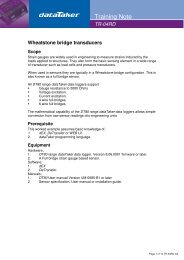You also want an ePaper? Increase the reach of your titles
YUMPU automatically turns print PDFs into web optimized ePapers that Google loves.
Memory Slot Commands and Protocol Hierarchy<br />
CAN networks can use a number of different higher level communications protocols. The following diagram illustrates the<br />
protocols used by each type of memory slot.<br />
RECV<br />
SEND<br />
RECVE<br />
SENDE<br />
RQST<br />
RECVJ<br />
RQSTJ<br />
GPS<br />
ISO 14230-3 / OBD-II<br />
Diagnostic Services<br />
Application Layer<br />
SAE J1939-71<br />
Vehicle Application Layer<br />
ISO 15765-2<br />
Network Layer<br />
SAE J1939-21<br />
Data Link / Network Layer<br />
CAN 2.0B PROTOCOL / ISO 11898-2<br />
Data Link / Physical Layer<br />
NMEA-0183<br />
CAN PORT 1<br />
CAN PORT 2<br />
GPS PORT<br />
<strong>CANgate</strong> protocol hierarchy<br />
As can be seen, the RECV, RECVE, SEND and SENDE memory slot types operate on raw CAN messages. A raw CAN<br />
message consists of an 11 or 29 bit identifier, plus 8 bytes of data.<br />
RQST memory slots allow parameters to be requested using standard automotive OBD (On Board Diagnostics) requests.<br />
The ISO 15765-2 network layer protocol is responsible for breaking up the request and response messages into multiple<br />
CAN frames, if required.<br />
RECVJ and RQSTJ memory slots allow broadcast and requested parameters to be read from a J1939 network. J1939 also<br />
incorporates a network layer which can break long messages up into multiple CAN frames.<br />
Finally, GPS memory slots allow fields of interest to be extracted from the NMEA-0183 data stream produced by a GPS<br />
device.<br />
Entering Commands<br />
<strong>CANgate</strong> memory slots and other settings are configured by sending textual commands via the host port. The available<br />
commands are detailed in the Command Reference (P16).<br />
If <strong>CANgate</strong> is directly connected to host computer then these commands can be entered using a terminal program (eg.<br />
DeTransfer).<br />
If <strong>CANgate</strong> is connected to the serial sensor port on a DT80/DT800 series data logger then the logger would be programmed<br />
to transmit commands and receive data using the 1SERIAL channel type. Refer to the logger User <strong>Manual</strong> for more details.<br />
<strong>CANgate</strong> commands are not case sensitive.<br />
Most commands have a set number of space-separated parameters. All parameters must be specified, unless a parameter<br />
is marked as optional.<br />
A parameter's data type will be specified as either:<br />
floating point – enter a decimal value, eg. 1.25, -4, 0.9907<br />
integer – enter a decimal or hexadecimal value, eg. 2309, 0xff07, -10 (hexadecimal values are prefixed by 0x)<br />
UM-0086-A2 <strong>CANgate</strong> User’s <strong>Manual</strong> Page 13



